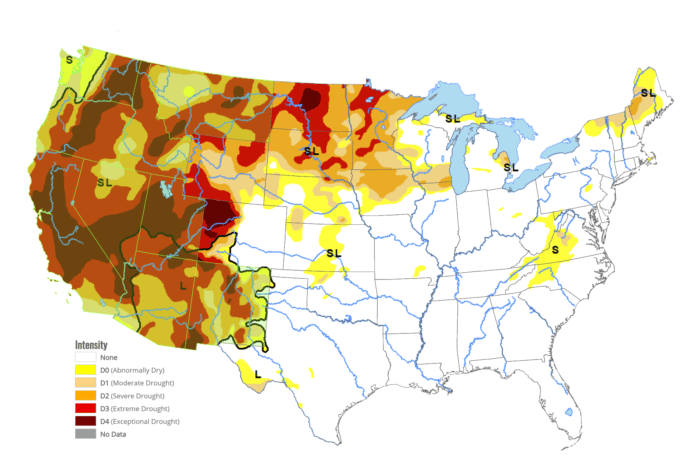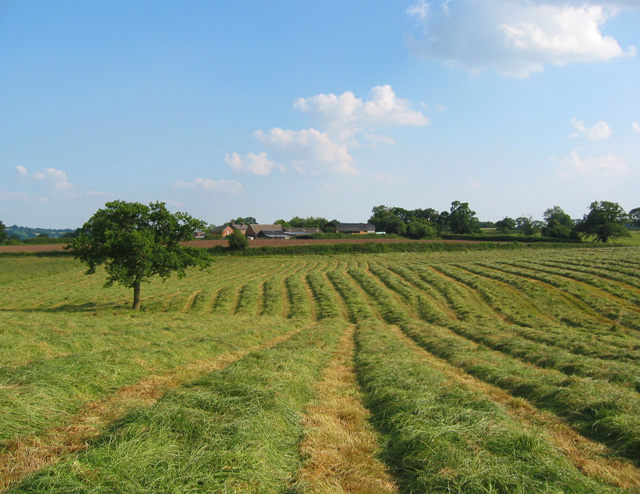by Margaret Smith, PhD Forage Agronomist
Late summer may be a good time to establish new forage seedings—if you have adequate soil moisture AND some rainfall is predicted. Success of a late-summer seeding is highly moisture dependent. Late summer temperatures are almost always sufficient to encourage rapid germination and establishment if there is soil moisture and rainfall to support that early growth.
Soil moisture conditions across the Upper Midwest are highly variable this growing season. Much of Minnesota and most of the Dakotas and northern Iowa are still experiencing drought conditions, while parts of Wisconsin, Michigan, Illinois and southern Iowa are well watered.
Seeding this next month may make good sense for farms in these well-watered areas.
Current Drought Map for the United States

Drought Map released from the U.S. Department of Agriculture on July 29, 2021. Source: droughtmonitor.unl.edu (click for interactive map).
Advantages and Disadvantages of Late-Summer Seedings
Advantages
- Increase first-year yields in 2022 compared to seeding next spring
- Annual weeds will be controlled by preplant tillage or foliarly applied herbicide application and freezing temperatures in the fall
- Soils at this time of the year are often better fit for preplant tillage, compared with frozen and wet soils in the spring
- Frees time in the spring for other operations
Disadvantages
- Requires a short-season crop that is harvested in mid- to late-summer to allow time for seeding
- Dry soils may delay or prevent germination
- Hot temperatures may dessicate and kill seedlings
- Herbicide residuals may damage new seedlings
- Emergence date must be back calculated/estimated six to eight weeks before the fall killing frost, which varies from year to year
Soil Testing and Fertility
Late summer is an excellent time to pull and update soil tests, and going into a mid- to long-term seeding is the perfect time to correct fertility needs.
Liming and pH
- Alfalfa: lime to pH 6.8
- Red Clover, White Clover, and Birdsfoot Trefoil: lime to pH 6.5
- Grass Hay or Pastures: lime to pH 6.0-6.5
Ideally, lime should be applied at least six months before seeding to allow time for reaction with the soil and some correction in pH. But if not done previously, now is the time before your current seeding! With your soil test results, follow your state guidelines for lime, phosphorus, potassium, and sulfur applications. Forage nutrient guidelines are available online for:
Check Herbicide History
Check the labels of the herbicide you applied this spring. Will crop rotation restrictions for those products allow planting a forage crop this fall? If not, wait and follow those label guidelines for planting dates.
Seeding Conditions
Ideal conditions in late summer for alfalfa and other forage seedings are:
- Moist soils, but not wet
- Moderate temperatures
- Rainfall predicted within the 10 to 14 days following seeding
Seeding Date
Forage crops should be seeded and emerge in time to allow six to eight weeks for growth before a killing freeze—usually 26o F. Use the planting dates on the graphic below as a general guide. Seedling forages may overwinter when seeded later, but growers assume a higher level of risk with this strategy.
Late-Summer Seeding Date for Alfalfa, Other Perennial Legumes, and Perennial Grasses
From: Alfalfa Management Guide, American Society of Agronomy
Exceptions to the planting dates noted in the graphic, above, include:
- Cool-season forage species that are slow to establish, such as reed canarygrass and birdsfoot trefoil should be seeded 10 days to two weeks before these dates.
- Don’t seed perennial warm-season pasture grasses–switchgrass, big bluestem or Indiangrass–in the late summer. There isn’t enough time for their establishment before fall freeze dates. Wait for a dormant seeding in winter or seed in the spring.
Soil Preparation
Can no-till work for late summer seedings? No-till is a good way to conserve limited late-summer soil moisture and can work following a short-season crop, such as canning vegetables, field peas, a small grain, or a single-cut warm season grass, like German/foxtail or proso millet. The best scenario for no-till is where moisture is ample, and your alfalfa or forage seeding follows immediately after the previous crop harvest. When summer crops are harvested several weeks before a planned forage seeding, there is likely too much time for weed growth that will compete with new seedlings. Weeds will either need to be tilled down or treated with herbicide before planting. Burning down the weed growth with a non-residual herbicide may still allow you to no-till drill the seeding.
Take fertility needs into consideration, though. Phosphorus, potassium, and sulfur can be strip-tilled into the field before seeding, but for best distribution these macronutrients and lime are best broadcast and incorporated.
If weed pressure or fertilizer applications require tillage, till only as deeply as you need to incorporate lime, fertilizer, or manure and to take out existing weeds. Firm the seedbed with a cultipacker or roller before seeding conventionally.
Seeding Depth
Seed ¼” to ½” deep for both forage legumes and grasses.
Weed Management
A great advantage of late-summer forage seedings is the relative ease of weed management. Neither herbicides nor companion-seeded small grains are needed for annual weed control. Fall freeze will eliminate any annual weed seedlings. An exception would be where perennial weeds are present. Late summer can be a good time to treat those with herbicide before seeding your forages.
Consider Alfalfa Autotoxicity
Don’t seed alfalfa into older, established alfalfa stands. Older alfalfa plants develop too high levels of their autotoxic compounds to allow good germination and root development of any new, nearby alfalfa seedlings. Wait at least 12 months following termination of a well-established, multi-year alfalfa stand before reseeding to alfalfa.
The exception to this rule: Alfalfa CAN be seeded into a thin, existing alfalfa stand in late summer, if that stand was seeded this spring. In the six-month period since spring seeding, autotoxic compounds will not have built to a level that will prevent germination and establishment of a fall seeding. Alfalfa also can be interseeded into older, grass-only hayfields or pastures without concern for autoxicity.
Red clover, white clover, and forage grasses don’t exhibit similar autotoxic traits.
Fall Forage Harvest from New Seedings
Harvesting late-summer seedings this in the fall does yield enough forage to warrant the cost of harvest. If though, forage is absolutely needed to get through the winter, an oat companion seeded with the perennial species will provide a moderate amount of forage with a fall cutting. Seed oats at a light rate ¾ to 1 bu/A to avoid too much competition with the new seeding. Cut oats at 4” or higher to avoid stressing the new forage seedlings before frost.
Resources
- Alfalfa Management Guide, American Society of Agronomy
- Late Summer Alfalfa Seeding, Dan Undersander, University of Wisconsin
- Planning a Late-Summer Perennial Forage Seeding?, Brain Lang, Iowa State University
- Soil pH Affects Forage Production, Charles White, Pennsylvania State University
- Steps to Successful No-till Establishment of Forages, Richard Leep and others, Michigan State University
- Summer reseeding (or seeding) of alfalfa, Craig Shaeffer, Krishona Martinson, and Jared Goplen, University of Minnesota

